Prices for corn, sorghum, and oats were lowered this month as US feed grain export prospects declined with plentiful world supplies. Barley prices received by farmers were projected higher because a higher-than-normal proportion of the crop is being sold at a premium as malting barley. Corn exports were lowered because of larger Southern Hemisphere crops. Increased global corn production is boosting projected ending stocks, especially in major corn-exporting countries.
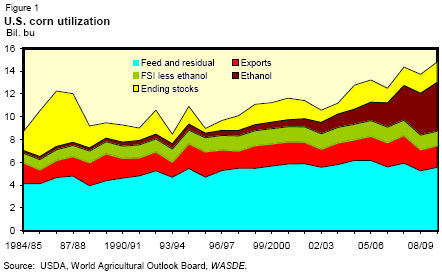
DOMESTIC OUTLOOK
Feed Grain Use Lowered This Month
US feed grain supplies for 2009/10 are decreased 628,000 metric tons this month to 398.9 million, up from 373.7 million for 2008/09, as barley imports and corn production were lowered. Total use of the four feed grains is projected 2.5 million tons lower at 348.6 million this month due to lower corn exports. US feed grain exports for 2009/10 are lowered 2.5 million tons to 52.2 million. The decrease in total use raises ending stocks 1.9 million tons to 50.3 million. In 2008/09, ending stocks for the four feed grains totaled 47.0 million tons.
Feed and residual use for the four feed grains plus wheat converted to a September- August marketing year is unchanged this month. Grain-consuming animal units (GCAU) are projected at 92.3 million this month, down slightly from 92.4 million last month. The annual Chickens and Eggs 2009 Summary, released February 22, 2010, by USDA’s National Agricultural Statistics Service, lowered layer numbers in the GCAU calculations. The lower layer numbers were somewhat offset by a slight increase in broiler numbers this month. Feed and residual use per animal unit is unchanged at 1.65 tons up from 1.56 tons in 2008/09.
Corn Use Prospects Down This Month for 2009/10
Total US supplies of corn in 2009/10 are expected to be 14.814 billion bushels, down 20 million from last month. Some survey respondents reported corn acreage as not yet harvested in Illinois, Michigan, Minnesota, and Wisconsin during the surveys conducted in preparation for the 12 January 2010, Crop Production 2009 Summary. These respondents were re-contacted in early February to determine how many of the acres were actually harvested or still intended for harvest and to record the actual production from those acres. Based on this updated information, several changes were made to the estimates published in January.
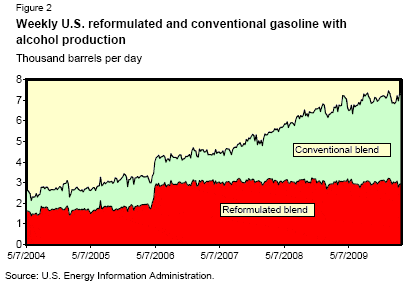
Corn harvested area declined 10,000 acres in Michigan but was unchanged in Illinois, Minnesota, and Wisconsin from the January estimates. Yields in both Illinois and Minnesota decreased 1.0 bushel per acre, while yields in Michigan and Wisconsin were unchanged. As a result of these changes, corn production in the United States is estimated at 13.131 billion bushels in 2009/10, down 20.43 million from the previous estimate. This month’s revisions also resulted in the national average yield being lowered 0.3 bushels per acre to 164.9 bushels, still a record.
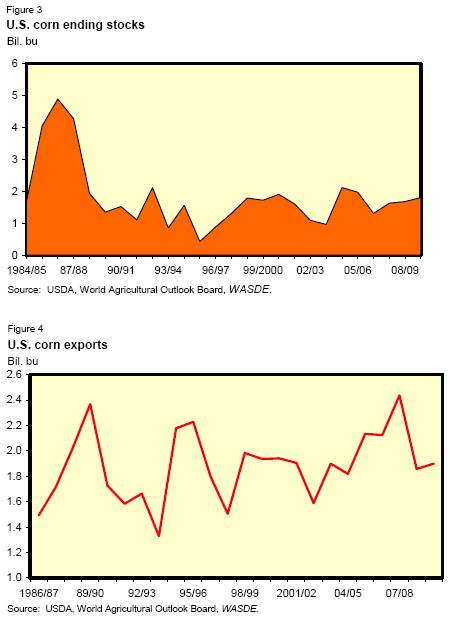
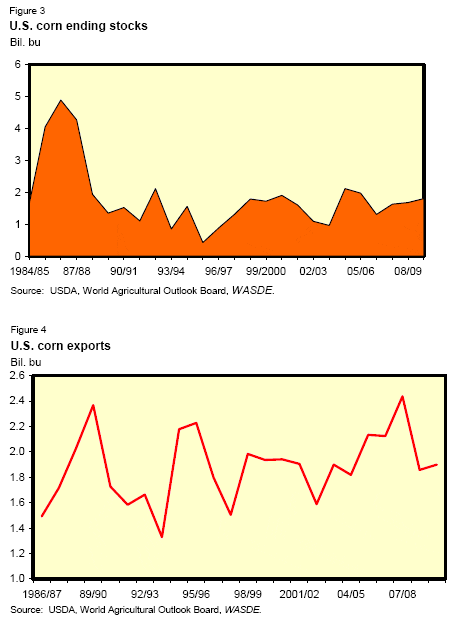
Because unharvested production is a component of onfarm stocks, changes were made to the December 1 onfarm stocks levels comparable with the production adjustments. Ending stocks were lowered 20.0 million bushels, with rounding at the State level accounting for the small difference between the production and stocks revisions. Since production was lowered 20.43 million bushels and stocks were only down 20.00, feed and residual use for the September-November quarter was lowered 430,000 bushels.
Total 2009/10 corn use is decreased 100 million bushels to 13.0 billion bushels this month due to a decrease in exports. Feed and residual and food, seed, and industrial use, including ethanol, are unchanged. Exports are lowered 100 million bushels to 1.9 billion, as a result of the increased availability of foreign corn supplies, particularly in Argentina. Ending stocks for 2009/10 are projected up this month to 1.799 billion bushels, from 1.719 billion last month.
Prices received by farmers for corn are expected to average $3.45 to $3.75 per bushel, down from $3.45 to $3.95 last month as increased export competition lowers price prospects during the remainder of the 2009/10 marketing year. Average prices received by farmers have been higher than the quoted market price as many farmers were able to lock in higher prices for their 2009-crop corn. Farmers typically price a portion of their production before harvest, sometimes even before planting, if prices are attractive.
Sorghum Prices Lowered From Last Month
US sorghum supplies and use are unchanged this month. Based on the 5-year average marketing weights through February, the weighted average price to date for sorghum is $3.17 per bushel, with 69 per cent of the crop expected to have been marketed. With lower corn prices expected this month, the price received by farmers was lowered to $3.05 to $3.35 per bushel, down from $3.10 to $3.50 last month.
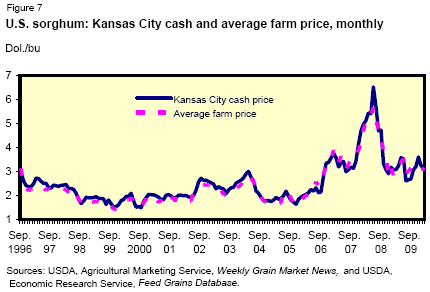
Barley Import Forecast Lowered
Total US supplies of barley for 2009/10 are expected to be 336.1 million bushels, down 5 million from last month and down 1.4 million from 2008/9. Imports were lowered this month to 20 million bushels from 25 million last month because of the slow pace of receipts to date. Total use in 2009/10 is forecast at 225 million bushels, unchanged from last month. Projected ending stocks are 111.1 million bushels, down 5 million from last month but up from 88.7 million from last year. Prices received by farmers for barley in 2009/10 are expected to average $4.40 to $4.60 per bushel, compared with $4.25 to $4.55 last month. Prices received by farmers reflect prices for both malting barley and feed barley. Malting barley prices have remained high and are a larger portion of the all-barley price this year than usual.
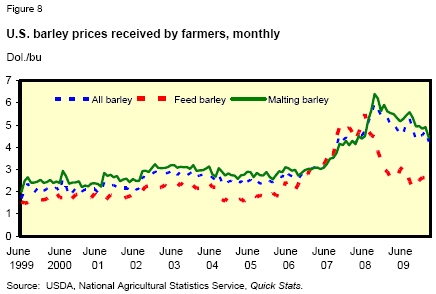
Oats Prices Lower
US oats supplies and use in 2009/10 are unchanged from last month but up slightly from 2008/09. Prices received by farmers are projected at $1.95 to $2.05 per bushel, down 5 cents on the low end of the range and down 15 cents on the high end of the range. The weighted average price received by farmers from June 2009 through February 2010, based on the average of the 5-year marketing weights, is $2.00, with 87 per cent of the crop expected to have been marketed.
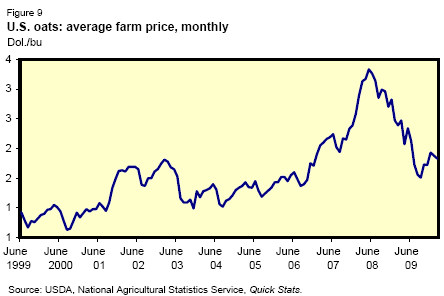
INTERNATIONAL OUTLOOK
A Sharp Increase in Foreign Corn Supplies Projected This Month
Global corn supplies forecast for 2009/10 are increased 6.4 million tons this month to 950.1 million. Production and trade revisions for 2008/09 boost 2009/10 world beginning stocks 0.5 million tons to 146.4 million. World corn production forecast for 2009/10 is increased 5.9 million tons to a record 803.7 million, exceeding 800 million for the first time, despite a small decline in the US crop.
Global coarse grain production is up less than the increase in corn because of a 1.2- million-ton reduction in barley production and small declines for mixed grain and rye in the EU. Still, world coarse grain production in 2009/10 is now projected to exceed 1.1 billion tons and nearly match the 2008/09 record.
Growing conditions for corn across the Southern Hemisphere have been generally very favorable, with Argentina and South Africa both receiving above-normal precipitation and mostly moderate temperatures during crucial reproductive growth stages. The above-normal rain in Argentina is not surprising because the ongoing El Nino condition in the Pacific is associated with heavy rain in Argentina’s main corn region. However, El Nino is also associated with drought in the Maiz Triangle of South Africa, yet actual temperatures and precipitation have been exceptionally favorable.
Argentina’s corn production is forecast up 3.8 million tons this month to 21.0 million. With the good rains, late planting was more extensive than expected, boosting area harvested 0.35 million hectares to 2.5 million. Harvesting has just begun, and crop conditions are generally reported to be good to excellent. Current conditions support the projected record 8.4 tons per hectare average yield. The areas that have received excessive rains are well enough drained to limit damage. Favorable conditions have also led to a larger-than-expected area planted to sorghum, boosting production prospects 0.5 million tons to 3.8 million. However, for barley, heavy rains late in the growing season and during harvest reduced yields and damaged quality, cutting production 0.4 million tons to 1.2 million. Additionally, a reassessment of corn supply and use for 2008/09 in Argentina, as the local marketing year draws to a close, reveals that corn production must have been significantly larger than previously estimated despite the severe drought. Corn area for 2008/09 is increased 10 per cent this month, increasing estimated production 2.4 million tons to 15.0 million.
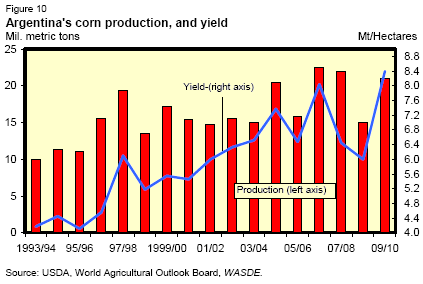

South Africa had very favorable temperatures and precipitation during January and February 2010, supporting 2009/10 corn crop prospects. However, continued rains are needed during March to support grain fill. South Africa reported revised area, up 5 per cent, as seedings exceeded earlier expectations. Moreover, current conditions support above-trend yields, and production is projected up 2.0 million tons this month to 13.5 million tons. This is the largest corn production since the 1980/81 record when area was more than a third larger.
Corn production for 2009/10 was increased 0.3 million tons this month for both Moldova and Cambodia, based on larger reported area. Iran’s corn production is projected up 0.2 million tons due to increased area, while both area and yield combined to boost corn production in the Philippines by a similar amount. Increased yields led to small increases in corn production for Croatia and Saudi Arabia. There are decreases in projected corn production this month due to reduced area for India, down 0.5 million tons, and for Chile, down fractionally.
China’s barley production is revised down 0.6 million tons to 2.5 million based on a report from the US Embassy. Mexico’s barley production is cut 0.3 million tons to 0.5 million as dryness cut harvested area and yields.
As more complete information and data about 2008/09 production, trade, and use becomes available, ending stocks are revised, changing supplies for 2009/10. This month there are numerous changes to 2009/10 corn beginning stocks, mostly caused by 2008/09 trade revisions. The largest change is for South Africa, up 0.5 million tons as reduced 2008/09 exports boost stocks. Argentina’s corn stocks are up 0.4 million tons due to increased 2008/09 production, and India’s corn stocks are boosted 0.2 million tons due to lower estimated food use in 2008/09. There are smaller increases in 2009/10 corn beginning stocks this month for the Dominican Republic, Panama, the Philippines, Moldova, Egypt, Yemen, Georgia, Cambodia, Saudi Arabia, and Jordan. Revised old-crop production for Iran and increased 2008/09 exports in Paraguay trimmed corn stocks 0.3 million tons each. There are smaller reductions in corn stocks this month for Chile, Syria, Malaysia, Guatemala, Taiwan, and Honduras.
Projected Consumption Little Changed This Month
Global coarse grain consumption in 2009/10 is projected at 1,105.6 million tons, nearly unchanged this month. World corn use is forecast to reach 809.9 million tons, up slightly this month. The largest change in projected consumption is a 1.0- million-ton reduction in food use of corn in India, based on revisions recommended by the post (the US Embassy in India). The reduced food use accommodates lower production and increased exports. The 2008/09 estimated corn food use was also reduced. Chile and Iraq also have small reductions to forecast corn use this month. However, these reductions are offset by increased feed use for Moldova, up 0.3 million tons; larger food use for Cambodia, up 0.3 million; an increase for both food and feed in South Africa, up a combined 0.2 million; and smaller increases for Malaysia, Yemen, and Georgia.
Increased Supplies Boost Global Corn Stocks, Especially for Exporters
With projected world corn use nearly unchanged in 2009/10, increased corn supplies boost expected ending stocks 6.1 million tons this month to 140.2 million. In round numbers, the February projections had 2009/10 ending stocks 12 million tons lower than beginning stocks, while in March the ending stocks are only 6 million tons below beginning stocks. Moreover, the increases in forecast ending stocks are largest for major exporting countries, putting added pressure on prices.
There are numerous changes in corn stocks projections this month due to adjustments in forecast supplies, use, and trade. Several countries have reduced corn stocks projected for 2009/10. Paraguay, with beginning stocks reduced by increased 2008/09 exports, has 2009/10 ending stocks cut by 0.3 million tons. Iran and Mexico are each trimmed 0.1 million tons, with even smaller reductions in projected ending stocks for Syria, Yemen, Guatemala, Taiwan, Georgia, and Honduras.
The list of countries with increased corn ending stocks prospects is more numerous and headed by major exporters. The largest increases are for the United States, up 2.0 million tons; Argentina, up 1.7 million; South Africa, up 1.3 million; Brazil, up 1.0 million; and India, up 0.2 million. There are also increases this month in 2009/10 ending stocks for the Philippines, Dominican Republic, Moldova, Malaysia, Saudi Arabia, Panama, Cambodia, Chile, Iraq, Egypt, and Jordan.
Increased Competition Slams US Corn Export Prospects
US October-September 2009/10 corn exports are cut 2.0 million tons to 48.0 million (cut 100 million bushels to 1.9 billion bushels for the September-August local marketing year). The reduction is caused by the increase in competition for sales during the remainder of 2009/10 expected from Argentina, and to a lesser extent, South Africa. According to Census export data, US corn shipments for October 2009 to January 2010 (the first third of 2009/10) were slightly higher (2 per cent) than the previous year. Inspections data for February 2010 indicate corn exports outpaced the previous year by more than in previous months. At the end of February, outstanding export sales exceeded year earlier levels by 17 per cent, supporting prospects for strong shipments in coming months. However, recent export prices indicate that Argentine corn is being sold at enough of a discount to US corn to make significant inroads in key markets such as South Korea and Japan. Additional US export sales for 2009/10 are expected to be reduced by the big crop in Argentina.
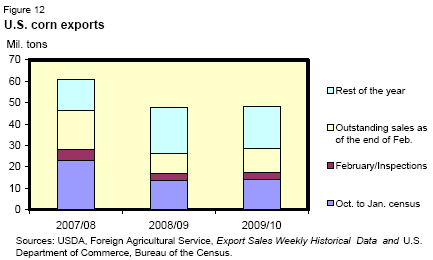
Argentina’s 2009/10 exports are boosted 2.5 million tons this month to 12.0 million. Larger-than-expected old-crop supplies have facilitated the granting of export licenses by the government, supporting larger shipments in the months before harvest, an unusual seasonal pattern. Moreover, the prospect of record yields for the new crop increases supplies for export in coming months.
India has been exporting corn more aggressively than expected to neighboring countries and Southeast Asia. Exports for 2009/10 are up 0.5 million tons this month to 1.5 million. Corn exports for Mexico and Croatia are each increased 0.1 million tons this month based on the pace of shipments.
South Africa’s 2009/10 October-September exports are unchanged this month at 2.5 million tons, but exports in recent months have been slower than expected. Local marketing year 2008/09 exports are cut 0.5 million tons this month. Local marketing year 2009/10 exports are boosted 1.0 million tons this month, due to the large crop, but a significant portion is expected to occur after the 2009/10 trade year is over.
Brazil is expected to suffer from increased competition from Argentina, so projected 2009/10 exports are cut 1.0 million tons to 8.0 million.
The only change this month in expected 2009/10 corn imports is for Malaysia, up 0.2 million tons to 2.8 million as prospects for broiler production have improved.
Changes to projected 2009/10 barley trade include a reduction for Argentina of 0.3 million tons to 0.6 million as a reduced crop and quality problems cut export opportunities. Partly offsetting is a 0.1-million-ton increase for Turkey to 0.6 million, based on recent export tenders, and a 0.1-million-ton increase for India.
Further Reading
| - | You can view the full report by clicking here. |
March 2010


